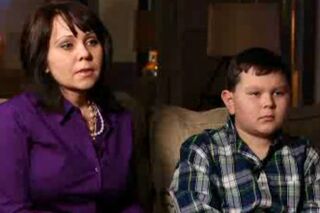Personality
Evaluating the Evidence for Reincarnation
Can deceased people somehow be reborn in a different body?
Posted December 20, 2021 Reviewed by Kaja Perina
Key points
- There are many cases of young children who report very specific details of an apparent past life, which are later verified.
- Some claim that children's reports of past lives could be the result of fraud, imagination, or embellishment.
- One striking case of past-life recall is Ryan Hammons, who made 55 very specific statements about a previous life that were verified.

The idea of reincarnation never sat particularly well with me. I used to think it was too neat and simplistic, a variation of the Christian reward-or-punishment-based afterlife — the idea that good deeds will lead to a better reincarnation in the next life, whereas bad deeds might result in spending your next life as a frog or worm.
However, in recent years I’ve become aware of well-documented cases of young children who have reported very specific details of a past life, which were later verified by investigators.
Research in this area was pioneered by Dr. Ian Stevenson, a psychiatrist at the University of Virginia School of Medicine, who spent much of his career collecting and examining such cases. Typically, between the age of 2 and 4 (with a mean age of 35 months) such children start talking about their previous life, often speaking about the events that led up to their death, and sometimes using the present tense as if their previous life was still continuing. In some cases, Stevenson was able to identify the person the child claimed to be and to verify the information by speaking to relatives of the deceased (1).
Since Stevenson’s death, other researchers have followed his lead. Now around 2500 reports of children’s past-life memories have been studied (2). Research has shown that normally the children’s reported previous lives ended prematurely and unnaturally, often involving violence, suicide, or an accident. In almost three-quarters of cases, the “previous personality” (in the term coined by Stevenson) died relatively young. A quarter died before the age of 15. On average, the previous personalities died four-and-a-half years before the birth of the children with whom they were associated (3).
Modern researchers meticulously check the accuracy of children’s accounts, analyzing any possibility that they gained information through more mundane ways or were fantasizing, or that their parents may be embellishing their stories. Often, researchers give the children recognition tests—for example, showing them a set of photos and asking them to pick the one which relates to their previous personality. They might be shown pictures of houses and asked to pick the one their previous personality lived in. They might be shown pictures of women and asked to pick which was their previous personality’s wife (4).
The most well-known contemporary researcher in this field is Jim Tucker, professor of psychiatry and neurobehavioral science at the University of Virginia. I’ll describe one of the remarkable cases Tucker has investigated here.
The Case of Ryan Hammons
Around the age of 4, Ryan Hammons told his mother Cyndi, “I think I used to be somebody else.” Whenever they saw the Hollywood sign on TV, Ryan would get excited, saying that was his home and he wanted to return there. He said that he had been an agent in Hollywood and that the agency had changed people’s names. He talked about dancing on Broadway and living in a house with a large swimming pool. Sometimes when songs came on the radio, he would stand up and start tap dancing. He talked about going to fancy parties with a “cowboy man” who had a horse that performed tricks and also did cigarette commercials. At school, when asked to draw pictures of his home, he would always draw four people—himself, his parents, and “the old me” (5).
Cyndi began to write down everything that Ryan told her about his past life. She borrowed books about Hollywood from the local library, hoping they would help Ryan process his memories. In one book, they found a still from an old movie called Night After Night. Ryan became very animated and shouted, “Mummy, that’s George—we did a picture together!” Then he pointed to a man to the side of the photo and said, “And that’s me.” Ryan had always said that he didn’t know the name of his previous personality, and at first Cyndi was unable to identify the man he pointed at. However, she found out that the other man was an actor named George Raft.
When Ryan was 5, his mother made contact with Jim Tucker, who agreed to investigate his claims. A film archivist (employed by a TV production company who made a documentary about Ryan) identified the man Ryan said was “me” as Marty Martyn, a dancer, actor, and agent who died in 1964. When Tucker visited Ryan and his parents, Ryan was asked to pick out photos of people and places that related to Marty Martyn, which he did successfully.
Most of Ryan’s statements about his previous life had been recorded by his mother before Tucker got involved, and before Marty Martyn was identified. Some statements had already been verified by his mother. For example, she had confirmed that the cowboy friend he often spoke about was a man called Wild Bill Elliot. With Tucker’s help, other statements were verified from sources such as public records at national archives, newspapers, obituaries, travel documents, and census reports. (Since Martyn was an obscure figure, there was no information about him on the internet, at least at that time.) Martyn’s daughter was contacted and verified other statements.
In total, 55 of Ryan’s statements about his previous life were verified. For example, it was confirmed that Marty Martyn was once a tap dancer, that he ran a talent agency that changed people’s names, that he had several wives, that his favorite restaurant was in Chinatown, that he spent a lot of time in Paris, that he had a large collection of sunglasses, that he bought his daughter a dog when she was 6, and so on. When Cyndi took him to the beautiful old building where the Marty Martyn Talent Agency had once been, he acted “as if he were truly returning home after a long journey...His whole face lit up with joy” (6).
Now a teenager, Ryan no longer has memories of his previous personality, but still seems to carry some behavioral traits from his last life. For example, he loves to watch old movies and listen to big band music from the '40s and '50s. (For further information, see this video about Ryan Hammons.)
Other Explanations?
Are there any alternative ways of explaining this case, and many other similar ones? Young children have vivid imaginations, so perhaps they are simply fantasizing. However, there are hundreds of cases in which the details of the children’s stories have been verified, which wouldn’t be the case if they were just making up random stories of a previous life.
Another skeptical explanation might be that the children have overheard their parents talking about certain people and have constructed stories based on the information. However, in the vast majority of cases, the previous personality was someone completely unknown to the family who lived far away from them.
More mundanely, is it possible that parents simply feed information to their children? Perhaps parents pick a deceased person, find out about their life through the internet, and coach their children to pretend to be the person? However, in many cases (such as Ryan’s) there are documents showing many specific details before the children are linked to their previous personalities. In addition, since children start speaking about their previous personalities at a very young age—in most cases before they are three—it seems highly unlikely that they would be able to process and retain detailed information and be able to relay the information accurately to investigators.
In any case, a large number of cases date from the pre-internet era, when detailed information about deceased people was hard to obtain. And even most post-internet cases relate to obscure ordinary people, whose lives are not recorded in great detail. In many cases, it is difficult to find any information about them online at all, and researchers are obliged to search through specific databases or population records.
All in all, this evidence makes me feel that I have no choice but to accept that reincarnation is real. As a scientist, I feel obliged to revise my views in the face of evidence. As I point out in my book Spiritual Science, it appears that the idea of life after death is more than a naive superstition. In Shakespeare’s famous play, Hamlet describes death as “the Undiscover’d country from whose bourn no traveller returns.” But perhaps it is possible to return from death, and to even remember the previous journey we took there.
References
(1) Stevenson, I,. (1980). Twenty Cases Suggestive Of Reincarnation. Charlottesville, VA: University of Virginia Press
(2) 'Fifty Years of Research.' https://med.virginia.edu/perceptual-studies/our-research/children-who-report-memories-of-previous-lives/fifty-years-of-research/
(3) Mills, A., & Tucker, J. B. (2014). Past-life experiences. In E. Cardeña, S. J. Lynn, & S. Krippner (Eds.), Varieties of anomalous experience: Examining the scientific evidence (pp. 303–332). American Psychological Association. https://doi.org/10.1037/14258-011
(4) Tucker, J. (2021) Cases of the reincarnation type. In Kelly, E & Marshall, P. (Eds.). Consciousness unbound.. Lanham, Maryland: Rowman & Littlefield.
(5) ibid.
(6) Kean, L. (2017). Surviving death. New York: Three Rivers Press, p. 66.




